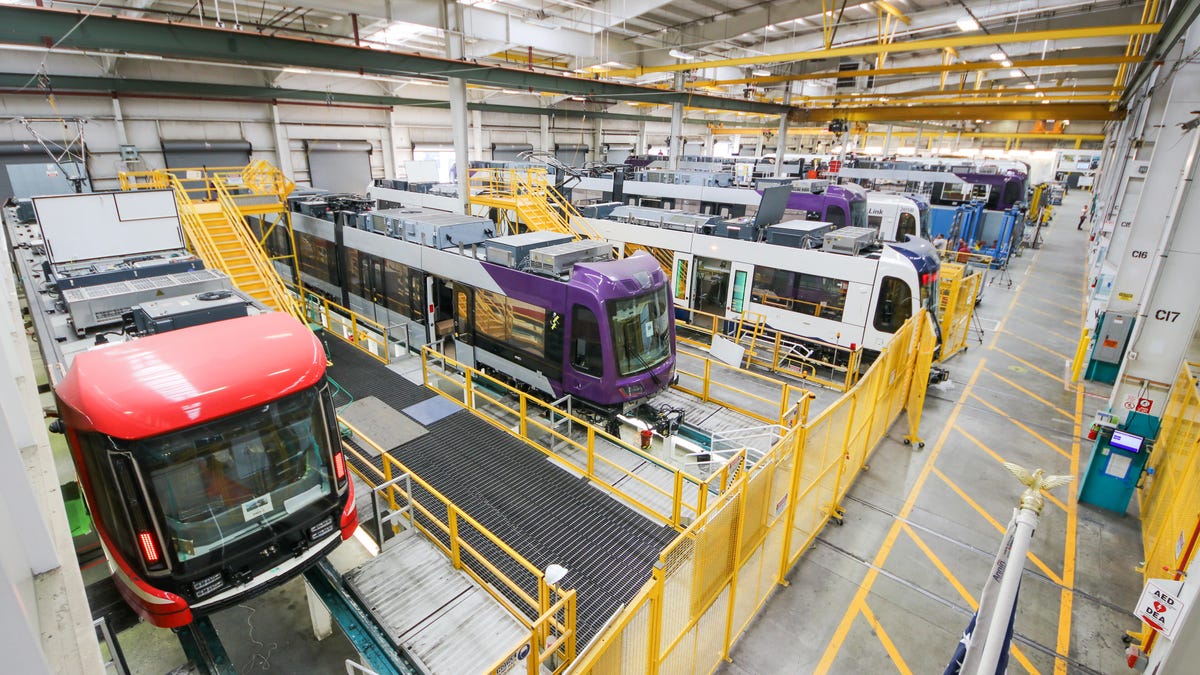 Why You Can Trust CNET
Why You Can Trust CNET Where trains are born: Touring the Siemens Mobility factory
Many of the locomotives, railcars and trams used throughout the US are built in a huge factory in Northern California. Here's how.

Trams at the Siemens Mobility factory
From the outside, it's hard to tell there's anything going on. The adjacent roads are fairly small, and the fence isn't particularly tall or imposing. Even after you get past the security gate, there's little to tell you that there are big things going on inside. And I mean big in the literal sense: they make trains here.
The Siemens Mobility factory, just south of Sacramento in Northern California, manufactures locomotives, railcars and trams that run both in and between cities all over the US and Canada. From Seattle to Atlanta, San Diego to Quebec, you've probably seen a vehicle built in this factory. Or now that you know what to look for, you will.
CNET had a rare behind-the-scenes look at how steel, aluminum and plastic are combined into 4,400 horsepower locomotives, state-of-the-art railcars and traffic-reducing urban trams in this 60-acre, mostly solar-powered facility.
A streetcar named Avanto
During my visit, Siemens was building three main vehicle types: the Charger locomotive, Venture railcars and various streetcars like the S70 Avanto. Our tour started where the parts arrive from local suppliers and begin the long process of fitting, welding and machining to form even larger parts that eventually become something train-shaped.
Walking through the expansive factory, human welders join metal to metal, separated by blue-blocking red barriers. Robotic welders stand ready to accept sheets of steel dozens of yards long. Heavy-lift cranes loom overhead, ready to carry finished and unfinished parts around a shop floor that could comfortably hold several football games.
I've toured factories before, but there's a big difference building something small and mostly plastic that's designed to last a few years and something largely made of stainless steel designed to last decades. The scale isn't even the biggest part of that. At every stage there's testing, checks and double-checks. One such device sits on its own isolated foundation to ensure accuracy. On another, giant hydraulic presses test that everything is stable while lasers take precise measurements.
In yet another odd scene, a dozen or so streetcars, similar in design but wearing the different multicolored liveries of the cities that bought them, were nestled together while they got their final checks and interior fittings.
My favorite part, however, was seeing the Charger in various states of undress. In one part of the factory, workers construct the overall frame. In another, the engine and other heavy equipment get lowered into place before the roof is secured. Having toured a completed Charger not too long ago, it was a treat to see how they're built. Hard-hat equipped, I was even able to go under one, which is certainly a rare sight for most people.
I'll meet you at the station. You can be here by 4:30
After the build's complete and the testing done, the trans and trams get shipped out. Conveniently, and logically, the factory is adjacent to freight tracks. Two thousand completed vehicles have made their way from this factory out onto the rails that crisscross the nation and into service in dozens of cities. Perhaps you'll see one of the rolling stock pictured in the gallery above making its way around your town. If you do, take a picture and send it to me on Twitter or Instagram.
As well as covering audio and display tech, Geoff does photo tours of cool museums and locations around the world, including nuclear submarines, aircraft carriers, medieval castles, epic 10,000-mile road trips and more.
Also check out Budget Travel for Dummies, his travel book, and his bestselling sci-fi novel about city-size submarines. You can follow him on Instagram and YouTube.

